| 美術館(Akari) ルールと解き方Rules and how to solve Akari. |
ルール
Rules
- 黒枡以外は解答枡です。黒枡は問題の枡です。黒枡の白ぬき数字はこの黒枡の隣の枡(黒枡以外の最大四つの解答枡)に入る○(燈)の数です。数字のない黒枡の周りにはいくつ○が来るかはわかりません。 Except for the black cells, they are the answer cells. The black cells are the problem cells. The white number of the black cell is the number of ○ (lights) that enter the cell next to this black cell (up to four answer cell other than the black cell). We do not know how many circles come around the black problem cell without numbers.
- 縦または横に連続した解答枡(黒枡から黒枡まで)には○(燈)が必ず一つなければなりませんが二つ以上あってはいけません。 There must be at least one ○ (light) in the answer cells chain(from black cell to black cell) that are continuous vertically or horizontally. But there must not be more than one.
- 問題数字での指定と関係のないところに○(燈)が入ることもあります。 ○ (light) may be entered in a place that is not related to the specification in problem numbers.
(Akari means light.)
美術館の問題へ jump to Akari problem.
解くコツ
Tips for solving
解くポイントはまず問題で指定された○がぴたりと入るところが無いか探します。例えば数字の4の問題枡の周囲は4か所の○(燈)が決まります。数字が0のときは一つも入りませんので禁止の×マークをつけておくとよいでしょう。(×マークはメモでありつけなくても構いません。)
辺の問題枡や黒枡が並んでいるところでは最初から1,2,3の問題枡でも○(燈)が決まることがあります。 また他の場所の○(燈)が決まれば新たにぴったり○(燈)が決まる場所ができることもあります。
ある枡の○が決まるとその縦横に連続した解答枡は明るくなるということで白枡にします。白枡・禁止の×の枡には○(燈)はおけません。
他の手筋は ある枡にに○(燈)を置くとどこかで問題数字指定の○(燈)が置けなくなれば 元の枡には○(燈)を置かない、 逆にある枡には○(燈)を置かないとどこかで問題数字指定の○(燈)が置けなくなれば 元の枡には○(燈)を置くことで見つけられます。 しかし毎回このように考えていたら大変です。ある問題数字の配置と○(燈)、禁止の×の配置パターンで上の基本に戻って考えると○(燈)、禁止の×置き方が決まるパターンがいろいろあります。 このパターンを見つけて覚えておくと解くのがスムーズになります。
それでは例題で説明します。
以下の説明では燈が有るか無いか、他の燈からの光があるか、燈禁止かわから無いなど未定の枡は灰色で、燈の光がさすと決まった枡は白で表示しています。 印刷されたパズルを解く時には光が当たるところには線を引くなどしても良いでしょう。解答があっているか間違っているかは燈が置かれる位置だけが判定のポイントです。 The point to solve is to first find out if there is any place where the circle specified in the question fits easily. For example, four circles (lights) are determined around the problem cell with the number 4.
If the number is 0, no entry will be made, so it is advisable to put a prohibited x mark. (The X mark is a memo and does not have to be attached.)
○ (light) may be determined even from 1, 2, and 3 problem cells from the beginning where the side problem cell and black cells are lined up.Also, if the ○ (light) of another place is decided, there may be a place where the ○ (light) can be decided.
When the circle of a certain cell is determined, the answer cell that continues vertically and horizontally becomes bright, so it is turned into a white cell. ○ (light) is not allowed in white cells and prohibited × cells.
If you put a circle (light) on a certain cell, and if the circle (light) specified by the problem number cannot be placed somewhere, do not place a circle (light) on the original cell. Conversely, if you do not put ○ (light) on a certain cell, if you can not place ○ (light) of the problem number designation somewhere, put ○ (light) on the original cell.If you think in this way, you can find the answer in some places.
However, it is difficult if you think like this every time. If you go back to the basics above with the layout of certain problem numbers and the arrangement pattern of ○ (light) and × of prohibition, there are various patterns that determine how to position ○ (light) and × of prohibition. Finding and remembering these patterns will make it easier to solve.
Let me explain with an example.
In the following explanation, undetermined cells such as whether there is a light, whether there is light from other lights, or whether light is prohibited or not are displayed in gray, and cells that are determined to be lighted are displayed in white.
When solving printed puzzles, you may draw a line where the light hits cells.Whether the answer is correct or incorrect is only the position where the light is placed.
|
次の図が問題です。黒い枡、白ぬき数字の黒枡が問題枡です。灰色の枡が解答枡です。 まず問題数字で指定されて○がちょうど入るところを探します。 この例では 右上の2の周りの水色枡に○がぴったり入ります。 The following figure is the problem. The black cells and the black cells with white numbers are the problem cells. The gray cell is the answer cell. First, search for the place where the circles are fit with the question number specified. In this example, the circle will fit exactly into the light blue cell around the top right corner. |
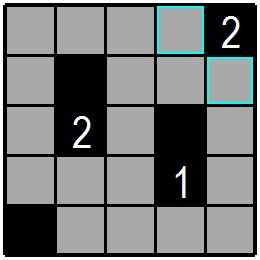
|
| ぴったり○(燈)が入るところに○を付けたあとは、 この○の縦横に繋がる解答枡には光が当たるということで白枡にします。 After adding a circle where exactly the circle (light) enters, The answer cells connected to the vertical and horizontal direction of this circle are white cells because light hits them. |
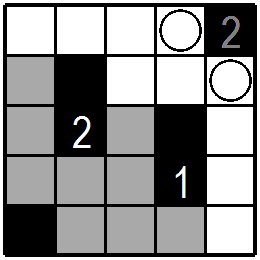
|
|
残った問題数字の2と1に注目してみましょう。 中ほどの問題枡2の斜め下の赤い枠の枡に燈(○)を置いたとするとその上と横には燈(○)を置けなくなります。 問題枡2の周りには燈(○)が置ける余地が3か所ありましたがそのうち2か所に燈(○)が置けなければ問題枡2では指定された燈(○)を設置できなくなります。 従って赤い枠の枡は燈禁止(×)となります。 同じように最下段の水色枠の枡に燈(○)を置いたとするとその上と右横には燈(○)を置けなくなります。 既に右上の2の下の燈(○)で白枡になっている枡を含めて問題枡1では指定された燈(○)を設置できなくなります。 従って水色枠の枡は燈禁止(×)となります。 Let's focus on the remaining problem numbers 2 and 1. If you put a light (○) on the red frame of the cell 2 diagonally below the middle problem cell 2, you will not be able to put a light (○) on the right cell and up side cell of it.Therefore, the red frame is prohibited (x). Similarly, if you put a light (○) on the light blue frame at the bottom, you will not be able to put a light (○) on the up side cell and the right side cell. It is not possible to set the specified light (○) in problem cell 1 including the cell already white with the lower light (○) in the upper right problem cell 2.Therefore, the light blue frame is prohibited (x). |
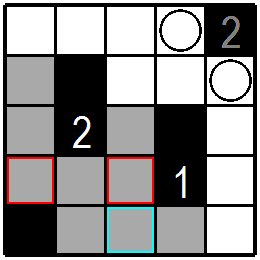
|
|
右下の問題枡1の周りで燈(○)が設置できるのは下の水色枠の枡だけとなりましたのでここに燈(○)が置かれます。 また問題枡2の右側の赤い枠の枡に燈をあてる(白枡にする)にはこの枡に燈(○)を設置するしかありません。 The light (○) can be set around the problem cell 1 at the lower right only in the light blue frame below, so the light (○) is placed here. In addition, the only way to put a light on the red frame on the right side of problem cell 2 (make it a white cell) is to install a light (O) on this cell. |
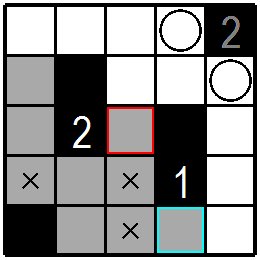
|
|
左下問題枡2の下の赤い枠の枡に燈(○)をあてようとするとこの枡にしか燈(○)を設置できませんので燈(○)を置きます。 この問題枡2の周りにはすでに燈(○)が2個設置されましたので残った水色枠の枡は燈禁止(×)となります。 If you try to apply a light (○) to the red frame below the lower left problem cell 2, you can only set a light (○) on this cell. Two lights (○) have already been installed around this problem cell 2, so the remaining light blue frame cells will be prohibited (×). |
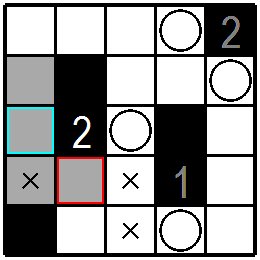
|
| 最後は左端の縦列です。燈が当たらない枡が二つ残っていますが、燈(○)を設置できるのは水色枠の枡しかありませんのでこの枡に燈(○)を置きます。 The last is the leftmost column. There are two cells that light does not hit, but there is only a light blue frame that can be used to set a light (○), so put a light (○) on this cell. |
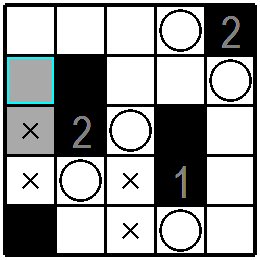
|
| これが正解です。 This is the correct answer. |
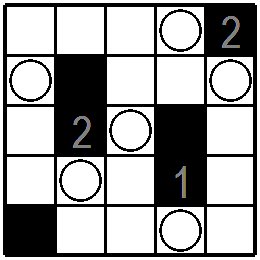
|
|
次に手筋のパターンを幾つか紹介しましょう。 次の図を見てください。左上の1の問題枡二つを見てみます。この配置では水色枠の二か所に燈(○)が置かれるか青色枠の二か所に燈(○)が置かれるかのどちらかです。 このため水色枠の枡と青色枠の枡に挟まれた解答枡には燈(○)が置かれなくなりますので燈禁止(× 青色で示しています)になります。 次は右上の緑の3と1が斜めに並んでいるパターンです。3の枡の左、下の枡ではどちらかの枡(緑枠の枡)にのみ燈(○)が置かれます。とすると3の右、上の枡には必ず燈(○)が置かれます。 (緑色の○)一方1の左、下には燈が置けませんので燈禁止になります。(緑の×) 次は左下の赤い二つ並んだ2です。左の2の左の枡に燈(○)を置かないと2の上下に燈(○)をおくことになり、右の2で指定された燈(○)が置けません。 したがって左の2の左の枡に燈(○)が置かれ、同様に右の2の右の枡にも燈(○)が置かれます。残りの燈は赤い枡の2か所かピンクの枡2か所に置かれます。 どちらに置かれるかはまだ分かりませんが横1列の他の解答枡には燈をおくことができませんので燈禁止(赤の×)となります。 Next, let's introduce some patterns of tips. See the following figure.Let's look at the two problem cells in the upper left corner. In this arrangement, either lights (○) are placed at two places in the light blue frames or a lights (○) are placed at two places in the blue frames. For this reason, the light (○) will not be placed on the answer cell sandwiched between the light blue frame and the blue frame, so light is prohibited (shown in blue ×). Next is a pattern in which the upper right green 3 and 1 are arranged diagonally. In the cells below and left of problem cell 3, a light is placed on only one of these cells (green cells).In this case, lights (○) must be placed on the up side and right side of problem cell 3.(Green circle) On the other hand, the lights cannot be placed on the left and bottom side of problem cell 1, so the lights are prohibited. (Green x) Next is the two consecutive red problem cell 2 in the lower left corner. If you do not place a light (○) on the left side cell of the left problem cell 2, you will put a light (○) above and below this problem cell 2, you can not put the light (○) specified by the right problem cell 2. Therefore, a light (○) is placed on the left side of left problem cell 2, and a light (○) is similarly placed on the right side of right problem cell 2. The remaining lights are placed in two places on the red cells or two places on the pink cells. I don't know where to put it yet, but I can't put a light on the other answer cells in the horizontal row, so they ares prohibited (red x). |
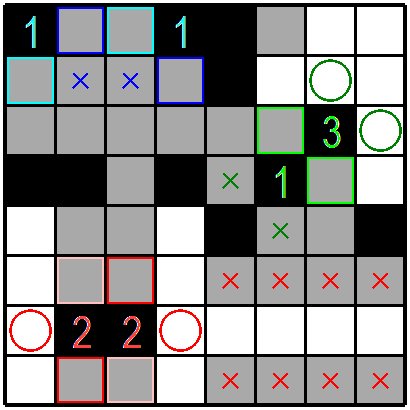
|
|
次の図を見てください。四隅の水色の1の問題枡を見てみます。ここでは4か所の水色枠の枡に燈(○)が置かれるか4か所の青色枠の枡に燈(○)が置かれるかのどちらかです。
このため水色枠の枡と青色枡の枡に挟まれた解答枡には燈(○)が置けなくなりますので燈禁止(× 青色で示しています)になります。 (ここでは手筋の考え方を示しているだけですので このままでは解がありません。) See the following figure. Let's take a look at the light blue problem cell 1 in each corner. Here, either lights (○) are placed on the four light blue frame cells or lights (○) are placed on the four blue frame cells. For this reason, the light (○) cannot be placed on the answer cells sandwiched between the light blue frame cell and the blue frame cell, so light is prohibited (shown in blue×). (Here, I only show the idea of the tips, so there is no solution as it is.) |
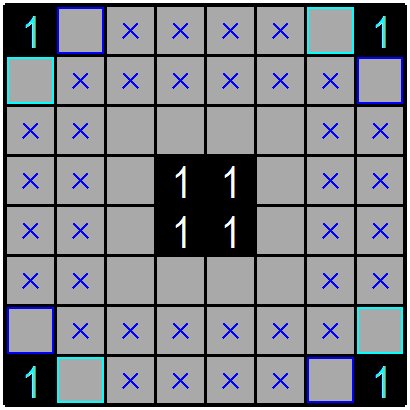
|
|
次の図を見てください。中央部の黄緑色の1の問題枡を見てみます。ここでは4か所の黄緑色の枡に燈(○)が置かれるか4か所の緑色枠の枡に燈(○)が置かれるかのどちらかです。
このため黄緑色枠の枡と緑色枡の枡の両方がある横(または縦)一連の解答枡には燈(○)が置けなくなりますので燈禁止(× 緑色で示しています)になります。 (ここでは手筋の考え方を示しているだけですので このままでは解がありません。) See the following figure. Let's look at the yellow-green problem cell 1 in the center. Here, either lights (○) are placed on four yellow-green cells or a lights (○) are placed on four green cells. For this reason, a series of horizontal (or vertical) answer cells that have both a yellow-green frame and a green frame can no longer have a light (○), so lighting is prohibited (shown in green ×). (Here, I only show the idea of the tips, so there is no solution as it is.) |
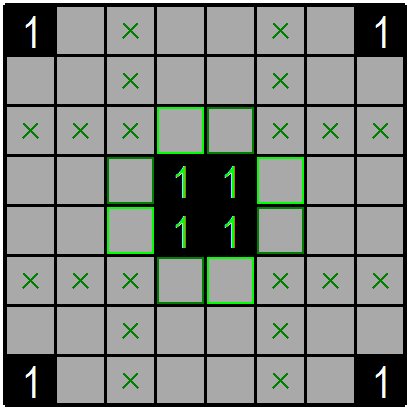
|
|
次の図を見てください。左上の黄緑色と緑色の一桝飛んで斜めに並んだ3を考えてみます。黄緑色の3の左と下の黄緑色枡の二つの枡に燈(○)を置くと
緑色の3の枡の周りに燈(○)を三つ置けなくなりますので黄緑色枠の枡二つの両方に燈(○)を置くことはできません。黄緑色の3の周りには 黄緑の○位置二つと
黄緑色枠の枡二つの一方に燈(○)が置かれることになります。同様に緑色の3の周りには緑の○位置二つと
緑色枠の枡二つの一方に燈(○)が置かれることになります。 さらに続きを右下の水色の3で考えてみます。それぞれの3では二つの燈(○)は決まっていますが 残りの一つは水色枠の枡に置かれるか青色枠の枡に置かれます。 水色枠か青色枠のどちらかに燈(○)が置かれると両方を含む横/縦のそのほかの枡には燈(○)が置けませんので燈禁止(× 水色で示しています)になります。 他にもいろいろありますし、他の枡からの燈(○)や問題枡が隣接していたりすると 上で説明した手筋と同じ考えかたが違う数字で成り立つこともあります。 See the following figure. Let's consider problem cell 3 that are arranged diagonally by flying one cell of yellow-green and green in the upper left. If you put a light (○) on two cells of the yellow-green framed cell on the left and below the yellow-green prblem cell 3, it is not possible to place three lights (○) around the green problem cell 3, so it is not possible to put lights (○) on both of the two yellow-green framed cells. There are two yellow green ○ positions around yellow green problem cell 3 and one light (○) will be placed on one of the two yellow-green framed cells. Similarly, around green problem cell 3, there are two green lights (○) and one light (○) will be placed on one of the two green framed cells. Let's consider the continuation with light blue 3 in the lower right. In each of the three, the two lights (○) are fixed, but the other one is placed in the light blue framed cells or the blue framed cells. If a light (○) is placed in either the light blue framed cells or the blue framed cell, the light (○) cannot be placed in other horizontal / vertical cells including both, so the light is prohibited (× light blue). There are many other tips, and if there are lights (○) from other cells or problem cells adjacent to each other, the same way of thinking as in the above explanation may be made up of different problem numbers. |
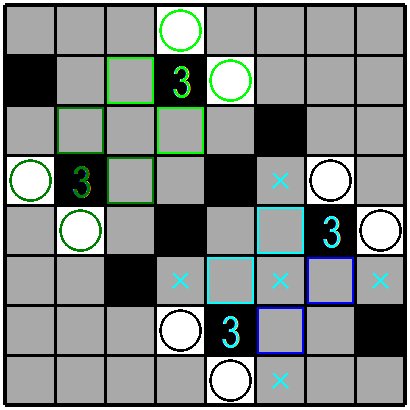
|
2020.2.28修正
2010.6.12作成
鴈野さんちのHomePage Top.
ご感想などは鴈野 敏生 まで。 2020.2.28 Modified
2010.6.12 First edition
Jump to top of Karino's HomePage.
mail to T.Karino